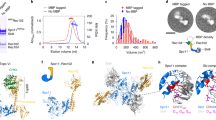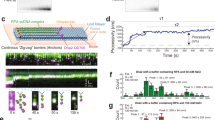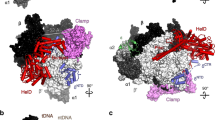Abstract
The conserved core of the exosome, the major eukaryotic 3′ → 5′ exonuclease, contains nine subunits that form a ring similar to the phosphorolytic bacterial PNPase and archaeal exosome, as well as Dis3. Dis3 is homologous to bacterial RNase II, a hydrolytic enzyme. Previous studies have suggested that all subunits are active 3′ → 5′ exoRNases. We show here that Dis3 is responsible for exosome core activity. The purified exosome core has a hydrolytic, processive and Mg2+-dependent activity with characteristics similar to those of recombinant Dis3. Moreover, a catalytically inactive Dis3 mutant has no exosome core activity in vitro and shows in vivo RNA degradation phenotypes similar to those resulting from exosome depletion. In contrast, mutations in Rrp41, the only subunit carrying a conserved phosphorolytic site, appear phenotypically not different from wild-type yeast. We observed that the yeast exosome ring mediates interactions with protein partners, providing an explanation for its essential function.
This is a preview of subscription content, access via your institution
Access options
Subscribe to this journal
Receive 12 print issues and online access
$189.00 per year
only $15.75 per issue
Buy this article
- Purchase on Springer Link
- Instant access to full article PDF
Prices may be subject to local taxes which are calculated during checkout





Similar content being viewed by others
References
Mitchell, P., Petfalski, E., Shevchenko, A., Mann, M. & Tollervey, D. The exosome: a conserved eukaryotic RNA processing complex containing multiple 3′ → 5′ exoribonucleases. Cell 91, 457–466 (1997).
Allmang, C. et al. The yeast exosome and human PM-Scl are related complexes of 3′ → 5′ exonucleases. Genes Dev. 13, 2148–2158 (1999).
Koonin, E.V., Wolf, Y.I. & Aravind, L. Prediction of the archaeal exosome and its connections with the proteasome and the translation and transcription machineries by a comparative-genomic approach. Genome Res. 11, 240–252 (2001).
Lorentzen, E. & Conti, E. Structural basis of 3′ end RNA recognition and exoribonucleolytic cleavage by an exosome RNase PH core. Mol. Cell 20, 473–481 (2005).
Buttner, K., Wenig, K. & Hopfner, K.P. Structural framework for the mechanism of archaeal exosomes in RNA processing. Mol. Cell 20, 461–471 (2005).
Symmons, M.F., Jones, G.H. & Luisi, B.F. A duplicated fold is the structural basis for polynucleotide phosphorylase catalytic activity, processivity, and regulation. Structure 8, 1215–1226 (2000).
Hernandez, H., Dziembowski, A., Taverner, T., Seraphin, B. & Robinson, C.V. Subunit architecture of multimeric complexes isolated directly from cells. EMBO Rep. 7, 605–610 (2006).
Lorentzen, E. et al. The archaeal exosome core is a hexameric ring structure with three catalytic subunits. Nat. Struct. Mol. Biol. 12, 575–581 (2005).
Oliveira, C.C., Gonzales, F.A. & Zanchin, N.I. Temperature-sensitive mutants of the exosome subunit Rrp43p show a deficiency in mRNA degradation and no longer interact with the exosome. Nucleic Acids Res. 30, 4186–4198 (2002).
Lehner, B. & Sanderson, C.M. A protein interaction framework for human mRNA degradation. Genome Res. 14, 1315–1323 (2004).
Estevez, A.M., Lehner, B., Sanderson, C.M., Ruppert, T. & Clayton, C. The roles of intersubunit interactions in exosome stability. J. Biol. Chem. 278, 34943–34951 (2003).
Raijmakers, R., Noordman, Y.E., van Venrooij, W.J. & Pruijn, G.J. Protein-protein interactions of hCsl4p with other human exosome subunits. J. Mol. Biol. 315, 809–818 (2002).
Butler, J.S. The yin and yang of the exosome. Trends Cell Biol. 12, 90–96 (2002).
Briggs, M.W., Burkard, K.T. & Butler, J.S. Rrp6p, the yeast homologue of the human PM-Scl 100-kDa autoantigen, is essential for efficient 5.8 S rRNA 3′ end formation. J. Biol. Chem. 273, 13255–13263 (1998).
Kadaba, S. et al. Nuclear surveillance and degradation of hypomodified initiator tRNAMet in S. cerevisiae. Genes Dev. 18, 1227–1240 (2004).
Wyers, F. et al. Cryptic pol II transcripts are degraded by a nuclear quality control pathway involving a new poly(A) polymerase. Cell 121, 725–737 (2005).
Vanacova, S. et al. A new yeast poly(A) polymerase complex involved in RNA quality control. PLoS Biol. 3, e189 (2005).
LaCava, J. et al. RNA degradation by the exosome is promoted by a nuclear polyadenylation complex. Cell 121, 713–724 (2005).
Mitchell, P. et al. Rrp47p is an exosome-associated protein required for the 3′ processing of stable RNAs. Mol. Cell. Biol. 23, 6982–6992 (2003).
van Hoof, A., Staples, R.R., Baker, R.E. & Parker, R. Function of the ski4p (Csl4p) and Ski7p proteins in 3′-to-5′ degradation of mRNA. Mol. Cell. Biol. 20, 8230–8243 (2000).
Takahashi, S., Araki, Y., Sakuno, T. & Katada, T. Interaction between Ski7p and Upf1p is required for nonsense-mediated 3′-to-5′ mRNA decay in yeast. EMBO J. 22, 3951–3959 (2003).
Cannistraro, V.J. & Kennell, D. The processive reaction mechanism of ribonuclease II. J. Mol. Biol. 243, 930–943 (1994).
Allmang, C. et al. Functions of the exosome in rRNA, snoRNA and snRNA synthesis. EMBO J. 18, 5399–5410 (1999).
Allmang, C., Mitchell, P., Petfalski, E. & Tollervey, D. Degradation of ribosomal RNA precursors by the exosome. Nucleic Acids Res. 28, 1684–1691 (2000).
Araki, Y. et al. Ski7p G protein interacts with the exosome and the Ski complex for 3′-to-5′ mRNA decay in yeast. EMBO J. 20, 4684–4693 (2001).
Chen, C.Y. et al. AU binding proteins recruit the exosome to degrade ARE-containing mRNAs. Cell 107, 451–464 (2001).
Dez, C., Houseley, J. & Tollervey, D. Surveillance of nuclear-restricted pre-ribosomes within a subnucleolar region of Saccharomyces cerevisiae. EMBO J. 25, 1534–1546 (2006).
Haile, S., Estevez, A.M. & Clayton, C. A role for the exosome in the in vivo degradation of unstable mRNAs. RNA 9, 1491–1501 (2003).
Mitchell, P. & Tollervey, D. An NMD pathway in yeast involving accelerated deadenylation and exosome-mediated 3′ → 5′ degradation. Mol. Cell 11, 1405–1413 (2003).
Vasudevan, S. & Peltz, S.W. Nuclear mRNA surveillance. Curr. Opin. Cell Biol. 15, 332–337 (2003).
Anderson, J.S. & Parker, R.P. The 3′ to 5′ degradation of yeast mRNAs is a general mechanism for mRNA turnover that requires the SKI2 DEVH box protein and 3′ to 5′ exonucleases of the exosome complex. EMBO J. 17, 1497–1506 (1998).
Amblar, M. & Arraiano, C.M. A single mutation in Escherichia coli ribonuclease II inactivates the enzyme without affecting RNA binding. FEBS J. 272, 363–374 (2005).
Tharun, S. & Parker, R. Analysis of mutations in the yeast mRNA decapping enzyme. Genetics 151, 1273–1285 (1999).
Muhlrad, D., Decker, C.J. & Parker, R. Deadenylation of the unstable mRNA encoded by the yeast MFA2 gene leads to decapping followed by 5′ → 3′ digestion of the transcript. Genes Dev. 8, 855–866 (1994).
Chekanova, J.A., Dutko, J.A., Mian, I.S. & Belostotsky, D.A. Arabidopsis thaliana exosome subunit AtRrp4p is a hydrolytic 3′ → 5′ exonuclease containing S1 and KH RNA-binding domains. Nucleic Acids Res. 30, 695–700 (2002).
Estevez, A.M., Kempf, T. & Clayton, C. The exosome of Trypanosoma brucei. EMBO J. 20, 3831–3839 (2001).
Chekanova, J.A., Shaw, R.J., Wills, M.A. & Belostotsky, D.A. Poly(A) tail-dependent exonuclease AtRrp41p from Arabidopsis thaliana rescues 5.8 S rRNA processing and mRNA decay defects of the yeast ski6 mutant and is found in an exosome-sized complex in plant and yeast cells. J. Biol. Chem. 275, 33158–33166 (2000).
Cheng, Z.F. & Deutscher, M.P. Purification and characterization of the Escherichia coli exoribonuclease RNase R. Comparison with RNase II. J. Biol. Chem. 277, 21624–21629 (2002).
Godefroy-Colburn, T. & Grunberg-Manago, M. Polynucleotide phosphorylase. in The Enzymes 3rd edn. (ed. Boyer, P.D.) 533–574 (Academic Press, New York, 1972).
Viswanathan, P., Chen, J., Chiang, Y.C. & Denis, C.L. Identification of multiple RNA features that influence CCR4 deadenylation activity. J. Biol. Chem. 278, 14949–14955 (2003).
Rigaut, G. et al. A generic protein purification method for protein complex characterization and proteome exploration. Nat. Biotechnol. 17, 1030–1032 (1999).
de la Cruz, J., Kressler, D., Tollervey, D. & Linder, P. Dob1p (Mtr4p) is a putative ATP-dependent RNA helicase required for the 3′ end formation of 5.8S rRNA in Saccharomyces cerevisiae. EMBO J. 17, 1128–1140 (1998).
Daugeron, M.C., Mauxion, F. & Seraphin, B. The yeast POP2 gene encodes a nuclease involved in mRNA deadenylation. Nucleic Acids Res. 29, 2448–2455 (2001).
Acknowledgements
We acknowledge C. Faux for constructing the dcp1-2 mutant strain, C. Henry (PAPSS, INRA, Jouy-en-Josas) for mass spectrometry analysis and the Unité Pilote (ICSN, Gif-sur-Yvette) for fermentation service. We are grateful to group members for useful discussions and S. Camier-Thuillier, A. Lebreton and F. Mauxion for manuscript corrections. A.D. was supported by fellowships from the Foundation for Polish Science and the Human Frontier Science Program. This work was supported by La Ligue contre le Cancer (Equipe Labellisée 2005), the Human Frontier Science Program, the Agence Nationale de la Recherche (ANR-05-BLAN-0062-03), Centre National de la Recherche Scientifique and the EU Sixth Framework Program 3D-Repertoire project (512028).
Author information
Authors and Affiliations
Contributions
A.D., supervised by B.S., designed and performed the majority of the experiments. E.L., with E.C., performed the initial sequence alignment for the subunits with similarity to archaeal phosphorolytic proteins and carried out expression of all recombinant proteins. A.D., E.L., E.C. and B.S. wrote the paper.
Corresponding authors
Ethics declarations
Competing interests
The authors declare no competing financial interests.
Supplementary information
Supplementary Fig. 1
Sequence alignment. (PDF 169 kb)
Supplementary Fig. 2
Nuclease assay. (PDF 727 kb)
Supplementary Fig. 3
dis3 growth phenotype. (PDF 340 kb)
Supplementary Fig. 4
rrp41 growth phenotype. (PDF 389 kb)
Supplementary Fig. 5
mRNA decay graph. (PDF 454 kb)
Supplementary Fig. 6
Dis3 activity. (PDF 232 kb)
Supplementary Table 1
Yeast strains. (PDF 77 kb)
Supplementary Table 2
Oligonucleotides. (PDF 49 kb)
Rights and permissions
About this article
Cite this article
Dziembowski, A., Lorentzen, E., Conti, E. et al. A single subunit, Dis3, is essentially responsible for yeast exosome core activity. Nat Struct Mol Biol 14, 15–22 (2007). https://doi.org/10.1038/nsmb1184
Received:
Accepted:
Published:
Issue Date:
DOI: https://doi.org/10.1038/nsmb1184
This article is cited by
-
RNA processing mechanisms contribute to genome organization and stability in B cells
Oncogene (2024)
-
piRNAs Interact with Cold-Shock Domain-Containing RNA Binding Proteins and Regulate Neuronal Gene Expression During Differentiation
Molecular Neurobiology (2022)
-
Molecular map of chronic lymphocytic leukemia and its impact on outcome
Nature Genetics (2022)
-
The zinc-finger protein Red1 orchestrates MTREC submodules and binds the Mtl1 helicase arch domain
Nature Communications (2021)
-
Genetic predisposition for multiple myeloma
Leukemia (2020)



